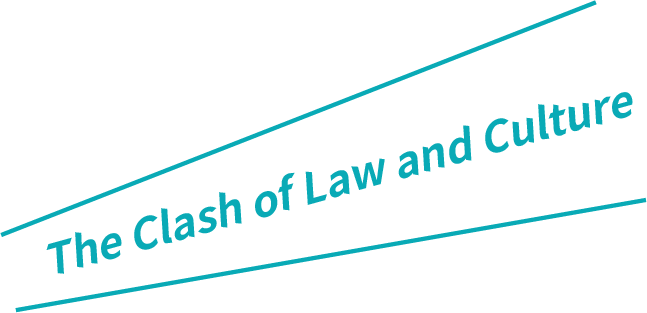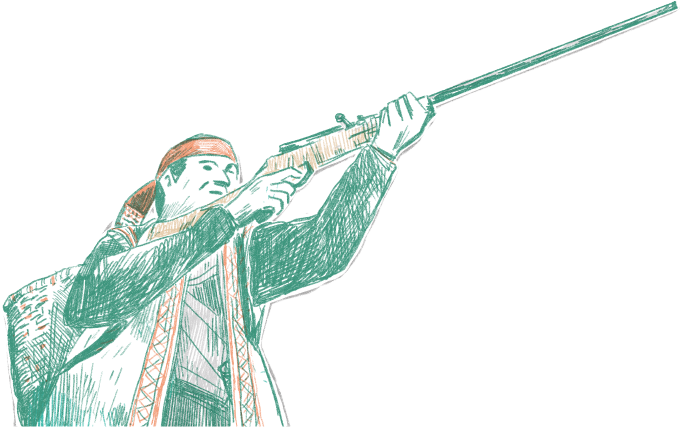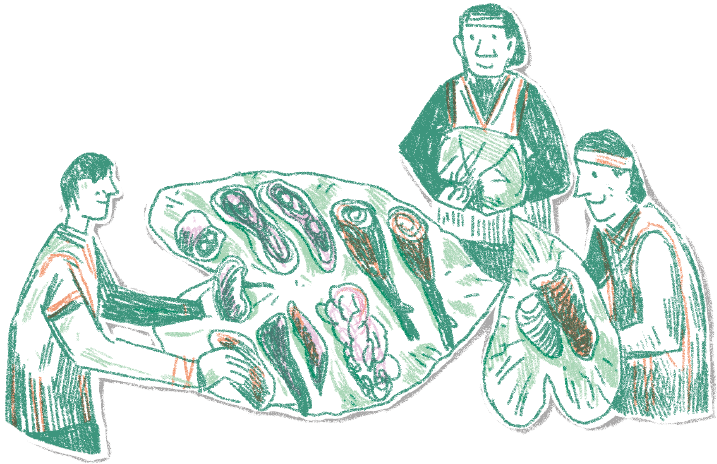

Talum Suqluman is a member of Bunun people who lives in a traditional indigenous community. One day in 2013, his 90-something-year-old mother wanted to have wild meat. As usual, he took up his hunting rifle and gears and walked into the woods he was familiar with. With the blessing of the mountains, he managed to capture two game animals and on his way back he was stopped by the police waiting in ambush at the foot of the mountain. The operation was not meant for arresting hunters but illegal loggers. The police comforted him that he shouldn’t be concerned about the ambush. All he had to do was to sign some papers. It did not occur to Talum Suqluman that the papers he signed resulted a heavy sentence of three-year-and-six-month imprisonment by the court.
On the eve of the enforcement of his prison term, the case drew public attention. Civic organizations launched several lobbying and rescuing operations ranging from demonstrations to constitutional interpretation. Instead of an acquittal, all these efforts only led to a “partially unconstitutional” ruling by the constitutional court in the end. After the constitutional ruling, on the day of the inaugural anniversary of President President Tsai Ing-wen’s second term, she pardoned Talum Suqluman. Although spared of serving the sentence, hunters remain to be criminals under the justice framework of Republic of China.
Back at the end of 2007, during the Mangayau festival of Katratripulr, a Pinuyumayan community in Taitung, members of the hunting group were interrogated by the police and taken back to the police station, causing the interruption of the ceremony. In March of the following year, dozens of indigenous communities across Taiwan joined forces and over a thousand people participated in the 308 March for Dignity on Ketagalan Avenue. The leaders entered the Executive Office of the President and conversed with the head of the state. Given that, the relevant laws and regulations have not yet seen changes. Coincidentally, the whole situation repeated itself again during the Mangayau ritual of Papulu, another Pinuyumayan community in Taitung in 2014, causing an uproar in the indigenous society.
Be it individual’s hunting activity for private consumption or group hunting for community rituals, they are both a part of indigenous day to day practice. Nevertheless, hunting has been repeatedly restricted and condemned by the modern society. What exactly are the frictions and conflicts between indigenous cultural norm and state law with regard to the issue of hunting?
Hunting Rifles and Culture: Who Gets to Define Tradition?
As a matter of fact, the current laws and regulations permit indigenous people to hunt, though the subsequent provisions failed not only to take ethnic cultures into consideration but also failed to exercise common sense.

Regulations in question
Hunters must submit an application one month in advance, and specify the intended types and quantity of the animal of his catch upon application.
Differences compared to cultural norm
In addition to traditional rituals, the need for the catch ranges from self-consumption to sharing with others on occasions like weddings, funerals and entertaining guests. On the one hand, we don’t have the crystal ball to know who will visit and who will die one month in advance. On the other, it is a taboo to predetermine the types and quantity of the preys before a hunt. The quantity of the catch, no matter big or small, is the gift from the mountains. When a hunter sets a goal beforehand, he runs the risk of upsetting the mountains. Or even worse, he may face danger.

Regulations in question
•To prevent the hunting rifle from becoming a criminal tool, the length of the gun must be more than 38 inches long to avoid easy concealed carry.
• It can only be fired in a single shot and continuous firing device is not allowed.
•The hunting rifle must be “self-made”, and ammunition can only be loaded from the muzzle of the gun, an outdated method.
•Cartridge (gunpowder and the bullet being held together with a cartridge case) is not allowed. The gunpowder and the “the filling materials” (steel and lead pellet, or glass lens) must be filled in separately.
Differences compared to cultural norm
•The government claims that “homemade hunting rifles” are the “traditional culture” of the indigenous peoples. However, historically speaking, the guns used by the indigenous peoples of Taiwan were imported. The guns were acquired by the indigenous peoples through means of war or trade after foreigners came to Taiwan in the 16th century. In other words, the hunting rifles used by the indigenous peoples from the very beginning were factory-produced “standard hunting rifles”, rather than “homemade hunting rifles.”
•The biggest problem with using homemade hunting rifles is safety. Because the guns are manufactured by hand, a well-designed safety is not guaranteed and the muzzle-loading rifles are prone to burst. According to statistics, the number of self-injure caused by indigenous hunters using hunting rifles is much higher than that of violent crimes committed with hunting rifles.
*Here only are examples of the regulations, not the full text.
We can tell that that the design of the state law fails to comprehend indigenous hunting culture. It is difficult every step of the way for indigenous people to lead a life following the teaching of their ancestors. They can easily become criminals by accident under the state law.

The Core Value of Hunting
is More About Sharing Than Killing
In addition to hunting-related regulations rubbing into indigenous culture, public opinions also show a lot of misunderstanding about hunting. Some animal protection groups have criticized that hunting is the cause of the decline of the number of wildlife. Also hunting involves killing and therefore should not be protected by the Constitution.
As a matter of fact, many seasoned wildlife conservationists have pointed out that the decline of wildlife populations in Taiwan is mainly due to the destruction of habitats as the result of development activities. Years of monitoring and research results show that indigenous hunting practice follows a set of cultural rules and taboos and is anything but indiscriminate hunting. Their practice helps to keep the balance wildlife populations in check in the area. Also indigenous hunters can be important source of information and partners when it comes to conducting survey of wildlife conservation.
Coming back to the indigenous perspective of hunting culture, it is definitely not the superficially about killing only. To cultivate a hunter, a trainee has to first learn to survive in the wild by familiarizing himself with the hunting grounds, fauna and flora and weather differences, etc. More importantly, a hunter is respected by his community not because of his excellent hunting skills but the number of people his catch can feed. Hunters who don’t know how to share are looked down upon by his community.
The lack of understanding of indigenous culture leads to the oversimplification and stigmatization of hunting culture and thus raises the bar for communication for social awareness. Hunting culture and wildlife conservation are not on the opposite end of a spectrum. Whereas the stigma of “conservation killer” has never stopped haunting indigenous hunters.
When Hunting Becomes a Crime:
How to Sustain Indigenous Culture?
The case of Talum Suqluman is only one of the many similar stories of indigenous hunters being sentenced to prison. As his case was portrayed as a loving son who went hunting because his old indigenous mother missed the taste of wild meat, the human-interest story became so high-profile one that it set many precedents in the judicial history of Taiwan.
In 2015, after the Supreme Court denied Talum Suqluman’s appeal, the sentence was confirmed. Right before the enforcement of prison sentence, civic organizations launched a rescue campaign and demanded the Supreme Prosecutors Office to lodge an extraordinary appeal.
At the end of 2015, the chief prosecutor filed an extraordinary appeal, and the Supreme Court accepted and suspended the execution of the sentence. Talum Suqluman’s case went back to trial.
In 2016, the Supreme Court trial started and the entire process was broadcasted online for the first time.
In 2017, the Supreme Court suspended the trial and took the initiative to file a motion for constitutional interpretation for the first time.
In 2021, the Constitutional Court convened oral argument, and for the first time publicly called for amicus curiae briefs.
On May 7, 2021, Justices of the Constitutional Court issued Interpretation No. 803, declaring the law was partially unconstitutional. The reasoning of the interpretation still shows a lack of understanding about indigenous hunting culture.
On May 20, 2021, President Tsai Ing-Wen exercised her pardon power for the first time to grant a pardon to Talum Suqluman on the anniversary day of presidential inauguration.
However, pardon does not equate acquittal and it only forgives someone’s sentence. The state still holds that Talum Suqluman committed a crime. The the label “hunting is a crime” is still firmly attached to indigenous hunters and shackles the indigenous peoples of Taiwan. Even after the President issued a pardon, the Supreme Court will continue to hear similar cases as its imperative. Talum Suqluman’s attorney team criticized that the grand justices were way too far from having an understanding of and respect toward cultural diversity at the press conference in response to the release of constitutional court ruling. They argued that these grand justices should go the the mountains and see for themselves the real hunting culture rather than relying on their own imagination. They reiterated that they will continue to defend Talum Suqluman and fight for a not guilty verdict. The story does not end here.
As an indigenous person, I can not help but question: when state law deprives a hunter his dignity and mainstream society denigrates and stigmatizes him, how is it possible for a hunter to lead the younger generation and transfer his knowledge of the mountains to them? When the legacy of hunting knowledge, wisdom, taboos are gone and there is no one to share his catch, leading to the discontinuation of rituals and ceremonies, with what can we carry on the legacy of indigenous cultures? Life is culture. Culture is tradition. Hunters are never criminals.





